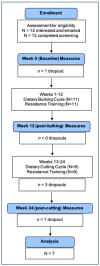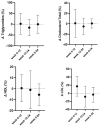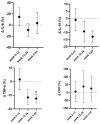A Pilot 24-Week 'Bulk and Cut' Dietary Protocol Combined with Resistance Training Is Feasible and Improves Body Composition and TNF-α Concentrations in Untrained Adult Males
- PMID: 40219022
- PMCID: PMC11990763
- DOI: 10.3390/nu17071265
A Pilot 24-Week 'Bulk and Cut' Dietary Protocol Combined with Resistance Training Is Feasible and Improves Body Composition and TNF-α Concentrations in Untrained Adult Males
Abstract
Background/Objectives: This study piloted a 24-week bodybuilding program combining resistance training (RT) with a dietary bulk-and-cut protocol in middle-aged adult males. Methods: Seven untrained males (33 ± 3.0 years; BMI = 35.0 ± 4.6 kg/m2; body fat = 36 ± 5%) completed a 24-week intervention combining RT with a dietary protocol consisting of 12-week cycles of caloric bulking (0-12 weeks) and cutting (12-24 weeks). The participant retention rate was 64%, while compliance with training was 96.7%, and adherence to dietary cycles was over 93%. To assess the preliminary efficacy of the intervention, venous blood samples and measurements of body composition (BodPod), muscle strength, and VO2max (cycle ergometer) were collected at baseline (week 0) and following the bulking (week 12) and cutting (week 24) cycles. Circulating lipids (triglycerides, total, low-density, and high-density cholesterol), C-reactive protein (CRP), tumor necrosis factor-alpha (TNF-α), interleukin-6 (IL-6), and interleukin-10 (IL-10) were measured in serum. Results: The training led to significant increases in muscle strength, especially in the deadlift (+46%, p < 0.001) and squat (+65%, p < 0.001). Improvements in body composition were characterized by an increase in fat-free mass and a decrease in body fat percentage over the 24-week intervention (+3% and -6%, respectively, p < 0.05). Lipids, CRP, IL-6, and IL-10 did not change significantly, but there was a notable reduction in TNF-α (time effect p = 0.05, pη2 = 0.39), with 15% lower concentrations at week 24 compared to baseline, indicating reduced inflammation. Conclusions: Overall, the pilot intervention achieved high compliance and adherence rates, leading to improvements in body composition and lower resting TNF-α concentrations in a group of middle-aged males with obesity.
Keywords: blood lipids; exercise and diet intervention; inflammation; obesity.
Conflict of interest statement
Author Bryan Allanigue was employed by Core Health Collective. The remaining authors declare that the research was conducted in the absence of any commercial or financial relationships that could be construed as a potential conflict of interest.
Figures




Similar articles
-
Chronic capsiate supplementation increases fat-free mass and upper body strength but not the inflammatory response to resistance exercise in young untrained men: a randomized, placebo-controlled and double-blind study.J Int Soc Sports Nutr. 2021 Jun 21;18(1):50. doi: 10.1186/s12970-021-00446-0. J Int Soc Sports Nutr. 2021. PMID: 34154603 Free PMC article. Clinical Trial.
-
Effects of Resistance Training on Muscular Adaptations and Inflammatory Markers in Overweight and Obese Men.Med Sci Sports Exerc. 2025 Mar 1;57(3):600-612. doi: 10.1249/MSS.0000000000003592. Epub 2024 Nov 15. Med Sci Sports Exerc. 2025. PMID: 39809255 Free PMC article. Clinical Trial.
-
The influence of resistance training on inflammatory markers, body composition and functional capacity in healthy older adults: A systematic review and meta-analysis.Arch Gerontol Geriatr. 2025 Mar;130:105731. doi: 10.1016/j.archger.2024.105731. Epub 2024 Dec 25. Arch Gerontol Geriatr. 2025. PMID: 39740358
-
CRP, but not TNF-α or IL-6, decreases after weight loss in patients with morbid obesity exposed to intensive weight reduction and balneological treatment.J Zhejiang Univ Sci B. 2015 May;16(5):404-11. doi: 10.1631/jzus.B1400219. J Zhejiang Univ Sci B. 2015. PMID: 25990058 Free PMC article.
-
The effect of exercise intensity on chronic inflammation: A systematic review and meta-analysis.J Sci Med Sport. 2021 Apr;24(4):345-351. doi: 10.1016/j.jsams.2020.10.004. Epub 2020 Oct 23. J Sci Med Sport. 2021. PMID: 33153926
References
-
- Paluch A.E., Boyer W.R., Franklin B.A., Laddu D., Lobelo F., Lee D., McDermott M.M., Swift D.L., Webel A.R., Lane A. Resistance Exercise Training in Individuals with and Without Cardiovascular Disease: 2023 Update: A Scientific Statement from the American Heart Association. Circulation. 2024;149:e217–e231. doi: 10.1161/CIR.0000000000001189. - DOI - PMC - PubMed
-
- Momma H., Kawakami R., Honda T., Sawada S.S. Muscle-strengthening activities are associated with lower risk and mortality in major non-communicable diseases: A systematic review and meta-analysis of cohort studies. Br. J. Sports Med. 2022;56:755–763. doi: 10.1136/bjsports-2021-105061. - DOI - PMC - PubMed
MeSH terms
Substances
Grants and funding
LinkOut - more resources
Full Text Sources
Research Materials
Miscellaneous

